毕业设计(论文)外文资料翻译封面
- 格式:doc
- 大小:84.50 KB
- 文档页数:1

本科生毕业设计(论文)外文资料专业班级:学生姓名:指导教师:年月日cannot be duplicated, transplanted, and copied. Using the fingerprint to carry on the status recognition is one of mature biological recognition technologies. As a kind of information carrier, IC card can carry on the encryption to the stored information. It deposits and withdrawals data quickly, favors carrying on modernized information management. The fingerprint IC card system is a perfect integration of the advanced fingerprint recognition technology and the smart IC card technology. The system can compare the registered fingerprint with original fingerprint saved in the IC card which is taken with the user. In addition, the fingerprint IC card system can save all the necessary information of a person such as fingerprint and identification, thus ensuring its flexibility and generality . So it can be widely used in finance, transportation, medical service, credential and other domains that need identification. It has broad application prospect.This article is from …….指纹是人体生物特征之一。
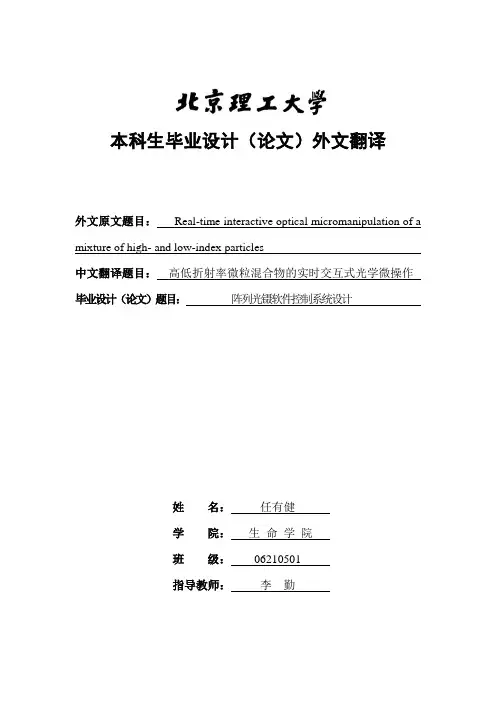
本科生毕业设计(论文)外文翻译外文原文题目:Real-time interactive optical micromanipulation of a mixture of high- and low-index particles中文翻译题目:高低折射率微粒混合物的实时交互式光学微操作毕业设计(论文)题目:阵列光镊软件控制系统设计姓名:任有健学院:生命学院班级:06210501指导教师:李勤高低折射率微粒混合物的实时交互式光学微操作Peter John Rodrigo Vincent Ricardo Daria Jesper Glückstad丹麦罗斯基勒DK-4000号,Risø国家实验室光学和等离子研究系jesper.gluckstad@risoe.dkhttp://www.risoe.dk/ofd/competence/ppo.htm摘要:本文论证一种对于胶体的实时交互式光学微操作的方法,胶体中包含两种折射率的微粒,与悬浮介质(0n )相比,分别低于(0L n n <)、高于(0H n n >)悬浮介质的折射率。
球形的高低折射率微粒在横平板上被一批捕获激光束生成的约束光势能捕获,捕获激光束的横剖面可以分为“礼帽形”和“圆环形”两种光强剖面。
这种应用方法在光学捕获的空间分布和个体几何学方面提供了广泛的可重构性。
我们以实验为基础证实了同时捕获又独立操作悬浮于水(0 1.33n =)中不同尺寸的球形碳酸钠微壳( 1.2L n ≈)和聚苯乙烯微珠( 1.57H n =)的独特性质。
©2004 美国光学学会光学分类与标引体系编码:(140.7010)捕获、(170.4520)光学限制与操作和(230.6120)空间光调制器。
1 引言光带有动量和角动量。
伴随于光与物质相互作用的动量转移为我们提供了在介观量级捕获和操作微粒的方法。
过去数十年中的巨大发展已经导致了在生物和物理领域常规光学捕获的各种应用以及下一代光学微操作体系的出现[1-5]。
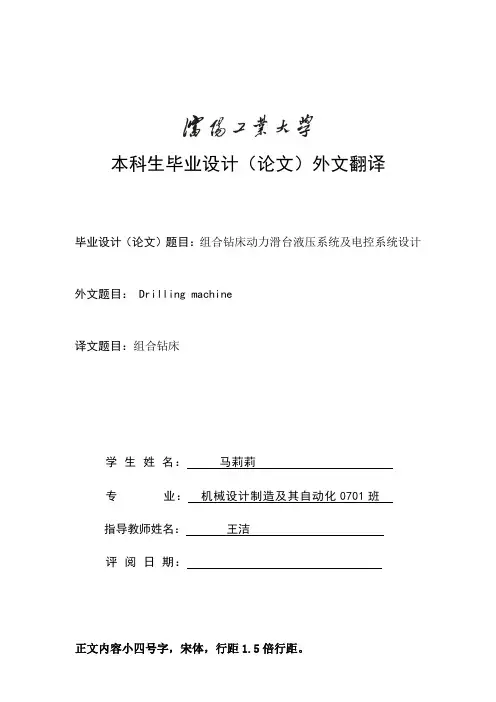
本科生毕业设计(论文)外文翻译毕业设计(论文)题目:组合钻床动力滑台液压系统及电控系统设计外文题目: Drilling machine译文题目:组合钻床学生姓名:马莉莉专业:机械设计制造及其自动化0701班指导教师姓名:王洁评阅日期:正文内容小四号字,宋体,行距1.5倍行距。
The drilling machine is a machine for making holes with removal of chips and it is used to create or enlarge holes. There are many different types of drilling machine for different jobs, but they can be basically broken down into two categories.The bench drill is used for drilling holes through raw materials such as wood, plastic and metal and gets its name because it is bolted to bench for stability so that larger pieces of work can be drilled safely. The pillar drill is a larger version that stands upright on the floor. It can do exactly the same work as the bench drill, but because of its size it can be used to drill larger pieces of materials and produce bigger holes. Most modern drilling machines are digitally automated using the latest computer numerical control (CNC) technology.Because they can be programmed to produce precise results, over and over again, CNC drilling machines are particularly useful for pattern hole drilling, small hole drilling and angled holes.If you need your drilling machine to work at high volume, a multi spindle drill head will allow you to drill many holes at the same time. These are also sometimes referred to as gang drills.Twist drills are suitable for wood, metal and plastics and can be used for both hand and machine drilling, with a drill set typically including sizes from 1mm to 14mm. A type of drill machine known as the turret stores tools in the turret and positions them in the order needed for work.Drilling machines, which can also be referred to as bench mounted drills or floor standing drills are fixed style of drills that may be mounted on a stand or bolted to the floor or workbench. A drilling machine consists of a base, column, table, spindle), and drill head, usually driven by an induction motor.The head typically has a set of three which radiate from a central hub that, when turned, move the spindle and chuck vertically, parallel to the axis of the column. The table can be adjusted vertically and is generally moved by a rack and pinion. Some older models do however rely on the operator to lift and re clamp the table in position. The table may also be offset from the spindles axis and in some cases rotated to a position perpendicular to the column.The size of a drill press is typically measured in terms of swing which can be is defined as twice the throat distance, which is the distance from the centre of the spindle to the closest edge of the pillar. Speed change on these drilling machines is achieved by manually moving a belt across a stepped pulley arrangement.Some drills add a third stepped pulley to increase the speed range. Moderndrilling machines can, however, use a variable-speed motor in conjunction with the stepped-pulley system. Some machine shop drilling machines are equipped with a continuously variable transmission, giving a wide speed range, as well as the ability to change speed while the machine is running.Machine drilling has a number of advantages over a hand-held drill. Firstly, it requires much less to apply the drill to the work piece. The movement of the chuck and spindle is by a lever working on a rack and pinion, which gives the operator considerable mechanical advantage.The use of a table also allows a vice or clamp to be used to position and restrain the work. This makes the operation much more secure. In addition to this, the angle of the spindle is fixed relative to the table, allowing holes to be drilled accurately and repetitively.Most modern drilling machines are digitally automated using the latest computer numerical control (CNC) technology. Because they can be programmed to produce precise results, over and over again, CNC drilling machines are particularly useful for pattern hole drilling, small hole drilling and angled holes.Drilling machines are often used for miscellaneous workshop tasks such as sanding, honing or polishing, by mounting sanding drums, honing wheels and various other rotating accessories in the chuck. To add your products click on the traders account link above.You can click on the links below to browse for new, used or to hire a drilling machine.Drilling machines are used for drilling, boring, countersinking, reaming, and tapping. Several types are used in metalworking: vertical drilling machines, horizontal drilling machines, center-drilling machines, gang drilling machines, multiple-spindle drilling machines, and special-purpose drilling machines.Vertical drilling machines are the most widely used in metalworking. They are used to make holes in relatively small work-pieces in individual and small-lot production; they are also used in maintenance shops. The tool, such as a drill, countersink, or reamer, is fastened on a vertical spindle, and the work-piece is secured on the table of the machine. The axes of the tool and the hole to be drilled are aligned by moving the workpiece. Programmed control is also used to orient the workpiece and to automate the operation. Bench-mounted machines, usually of the single-spindle type, are used to make holes up to 12 mm in diameter, for instance, in instrument-making.Heavy and large workpieces and workpieces with holes located along a curved edge are worked on radial drilling machines. Here the axes of the tool and the hole to be drilled are aligned by moving the spindle relative to the stationary work-piece.Horizontal drilling machines are usually used to make deep holes, for instance, in axles, shafts, and gun barrels for firearms and artillery pieces.Center-drilling machines are used to drill centers in the ends of blanks. They are sometimes equipped with supports that can cut off the blank before centering, and in such cases they are called center-drilling machines. Gang drilling machines with more than one drill head are used to produce several holes at one time. Multiple-spindle drilling machines feature automation of the work process. Such machines can be assembled from several standardized, self-contained heads with electric motors and reduction gears that rotate the spindle and feed the head. There are one-, two-, and three-sidedmultiple-spindle drilling machines with vertical, horizontal, and inclined spindles for drilling and tapping. Several dozen such spindles may be mounted on a single machine. Special-purpose drilling machines, on which a limited range of operations is performed, are equipped with various automated devices.Multiple operations on workpieces are performed by various combination machines. These include one- and two-sided jig boring machines,drilling-tapping machines (usually gang drilling machines with reversible thread-cutting spindles), milling-type drilling machines and drilling-mortising machines used mainly for woodworking, and automatic drilling machines.In woodworking much use is made of single- and multiple-spindle vertical drilling machines, one- and two-sided, horizontal drilling machines (usually with multiple spindles), and machines equipped with a swivel spindle that can be positioned vertically and horizontally. In addition to drilling holes, woodworking machines may be used to make grooves, recesses, and mortises and to remove knots.英文翻译指导教师评阅意见。
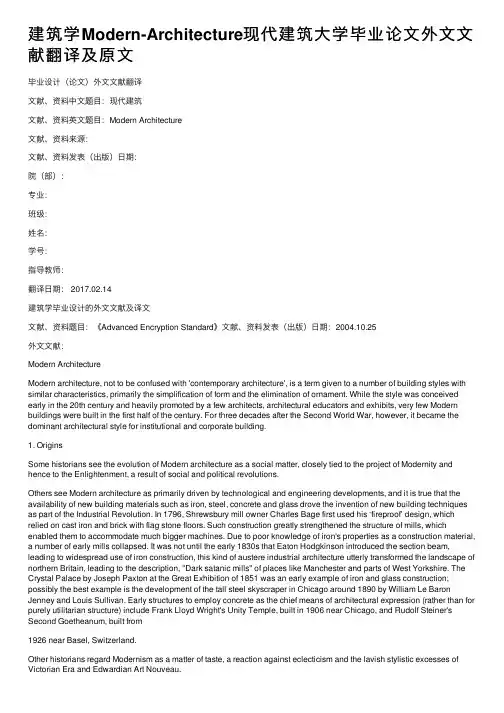
建筑学Modern-Architecture现代建筑⼤学毕业论⽂外⽂⽂献翻译及原⽂毕业设计(论⽂)外⽂⽂献翻译⽂献、资料中⽂题⽬:现代建筑⽂献、资料英⽂题⽬:Modern Architecture⽂献、资料来源:⽂献、资料发表(出版)⽇期:院(部):专业:班级:姓名:学号:指导教师:翻译⽇期: 2017.02.14建筑学毕业设计的外⽂⽂献及译⽂⽂献、资料题⽬:《Advanced Encryption Standard》⽂献、资料发表(出版)⽇期:2004.10.25外⽂⽂献:Modern ArchitectureModern architecture, not to be confused with 'contemporary architecture', is a term given to a number of building styles with similar characteristics, primarily the simplification of form and the elimination of ornament. While the style was conceived early in the 20th century and heavily promoted by a few architects, architectural educators and exhibits, very few Modern buildings were built in the first half of the century. For three decades after the Second World War, however, it became the dominant architectural style for institutional and corporate building.1. OriginsSome historians see the evolution of Modern architecture as a social matter, closely tied to the project of Modernity and hence to the Enlightenment, a result of social and political revolutions.Others see Modern architecture as primarily driven by technological and engineering developments, and it is true that the availability of new building materials such as iron, steel, concrete and glass drove the invention of new building techniques as part of the Industrial Revolution. In 1796, Shrewsbury mill owner Charles Bage first used his ‘fireproof’ design, which relied on cast iron and brick with flag stone floors. Such construction greatly strengthened the structure of mills, which enabled them to accommodate much bigger machines. Due to poor knowledge of iron's properties as a construction material, a number of early mills collapsed. It was not until the early 1830s that Eaton Hodgkinson introduced the section beam, leading to widespread use of iron construction, this kind of austere industrial architecture utterly transformed the landscape of northern Britain, leading to the description, "Dark satanic mills" of places like Manchester and parts of West Yorkshire. The Crystal Palace by Joseph Paxton at the Great Exhibition of 1851 was an early example of iron and glass construction; possibly the best example is the development of the tall steel skyscraper in Chicago around 1890 by William Le Baron Jenney and Louis Sullivan. Early structures to employ concrete as the chief means of architectural expression (rather than for purely utilitarian structure) include Frank Lloyd Wright's Unity Temple, built in 1906 near Chicago, and Rudolf Steiner's Second Goetheanum, built from1926 near Basel, Switzerland.Other historians regard Modernism as a matter of taste, a reaction against eclecticism and the lavish stylistic excesses of Victorian Era and Edwardian Art Nouveau.Whatever the cause, around 1900 a number of architects around the world began developing new architectural solutions to integrate traditional precedents (Gothic, for instance) with new technological possibilities. The work of Louis Sullivan and Frank Lloyd Wright in Chicago, Victor Horta in Brussels, Antoni Gaudi in Barcelona, Otto Wagner in Vienna and Charles Rennie Mackintosh in Glasgow, among many others, can be seen as a common struggle between old and new.2. Modernism as Dominant StyleBy the 1920s the most important figures in Modern architecture had established their reputations. The big three are commonly recognized as Le Corbusier in France, and Ludwig Mies van der Rohe and Walter Gropius in Germany. Mies van der Rohe and Gropius were both directors of the Bauhaus, one of a number of European schools and associations concerned with reconciling craft tradition and industrial technology.Frank Lloyd Wright's career parallels and influences the work of the European modernists, particularly via the Wasmuth Portfolio, but he refused to be categorized with them. Wright was a major influence on both Gropius and van der Rohe, however, as well as on the whole of organic architecture.In 1932 came the important MOMA exhibition, the International Exhibition of Modern Architecture, curated by Philip Johnson. Johnson and collaborator Henry-Russell Hitchcock drew together many distinct threads and trends, identified them as stylistically similar and having a common purpose, and consolidated them into the International Style.This was an important turning point. With World War II the important figures of the Bauhaus fled to the United States, to Chicago, to the Harvard Graduate School of Design, and to Black Mountain College. While Modern architectural design never became a dominant style in single-dwelling residential buildings, in institutional and commercial architecture Modernism became the pre-eminent, and in the schools (for leaders of the profession) the only acceptable, design solution from about 1932 to about 1984.Architects who worked in the international style wanted to break with architectural tradition and design simple, unornamented buildings. The most commonly used materials are glass for the facade, steel for exterior support, and concrete for the floors and interior supports; floor plans were functional and logical. The style became most evident in the design of skyscrapers. Perhaps its most famous manifestations include the United Nations headquarters (Le Corbusier, Oscar Niemeyer, Sir Howard Robertson), the Seagram Building (Ludwig Mies van der Rohe), and Lever House (Skidmore, Owings, and Merrill), all in New York. A prominent residential example is the Lovell House (Richard Neutra) in Los Angeles.Detractors of the international style claim that its stark, uncompromisingly rectangular geometry is dehumanising. Le Corbusier once described buildings as "machines for living", but people are not machines and it was suggested that they do not want to live in machines. Even Philip Johnson admitted he was "bored with the box." Since the early 1980s many architects have deliberately sought to move away from rectilinear designs, towards more eclectic styles. During the middle of the century, some architects began experimenting in organic forms that they felt were more human and accessible. Mid-century modernism, or organic modernism, was very popular, due to its democratic and playful nature. Alvar Aalto and Eero Saarinen were two of the most prolific architects and designers in this movement, which has influenced contemporary modernism.Although there is debate as to when and why the decline of the modern movement occurred, criticism of Modern architecture began in the 1960s on the grounds that it was universal, sterile, elitist and lacked meaning. Its approach had become ossified in a "style" that threatened to degenerate into a set of mannerisms. Siegfried Giedion in the 1961 introduction to his evolving text, Space, Time and Architecture (first written in 1941), could begin "At the moment a certain confusion exists in contemporary architecture, as in painting; a kind of pause, even a kind of exhaustion." At the Metropolitan Museum of Art, a 1961 symposium discussed the question "Modern Architecture: Death or Metamorphosis?" In New York, the coup d'état appeared to materialize in controversy around the Pan Am Building that loomed over Grand Central Station, taking advantage of the modernist real estate concept of "air rights",[1] In criticism by Ada Louise Huxtable and Douglas Haskell it was seen to "sever" the Park Avenue streetscape and "tarnish" the reputations of its consortium of architects: Walter Gropius, Pietro Belluschi and thebuilders Emery Roth & Sons. The rise of postmodernism was attributed to disenchantment with Modern architecture. By the 1980s, postmodern architecture appeared triumphant over modernism, including the temple of the Light of the World, a futuristic design for its time Guadalajara Jalisco La Luz del Mundo Sede International; however, postmodern aesthetics lacked traction and by the mid-1990s, a neo-modern (or hypermodern) architecture had once again established international pre-eminence. As part of this revival, much of the criticism of the modernists has been revisited, refuted, and re-evaluated; and a modernistic idiom once again dominates in institutional and commercial contemporary practice, but must now compete with the revival of traditional architectural design in commercial and institutional architecture; residential design continues to be dominated by a traditional aesthetic.中⽂译⽂:现代建筑现代建筑,不被混淆与'当代建筑' , 是⼀个词给了⼀些建筑风格有类似的特点, 主要的简化形式,消除装饰等. 虽然风格的设想早在20世纪,并⼤量造就了⼀些建筑师、建筑教育家和展品,很少有现代的建筑物,建于20世纪上半叶. 第⼆次⼤战后的三⼗年, 但最终却成为主导建筑风格的机构和公司建设.1起源⼀些历史学家认为进化的现代建筑作为⼀个社会问题, 息息相关的⼯程中的现代性,从⽽影响了启蒙运动,导致社会和政治⾰命.另⼀些⼈认为现代建筑主要是靠技术和⼯程学的发展, 那就是获得新的建筑材料,如钢铁, 混凝⼟和玻璃驱车发明新的建筑技术,它作为⼯业⾰命的⼀部分. 1796年, shrewsbury查尔斯bage⾸先⽤他的'⽕'的设计, 后者则依靠铸铁及砖与⽯材地板. 这些建设⼤⼤加强了结构,使它们能够容纳更⼤的机器. 由于作为建筑材料特性知识缺乏,⼀些早期建筑失败. 直到1830年初,伊顿Hodgkinson预计推出了型钢梁, 导致⼴泛使⽤钢架建设,⼯业结构完全改变了这种窘迫的⾯貌,英国北部领导的描述, "⿊暗魔⿁作坊"的地⽅如曼彻斯特和西约克郡. ⽔晶宫由约瑟夫paxton的重⼤展览, 1851年,是⼀个早期的例⼦,钢铁及玻璃施⼯; 可能是⼀个最好的例⼦,就是1890年由William乐男爵延长和路易沙利⽂在芝加哥附近发展的⾼层钢结构摩天楼. 早期结构采⽤混凝⼟作为⾏政⼿段的建筑表达(⽽⾮纯粹功利结构) ,包括建于1906年在芝加哥附近,劳埃德赖特的统⼀宫, 建于1926年瑞⼠巴塞尔附近的鲁道夫斯坦纳的第⼆哥特堂,.但⽆论原因为何, 约有1900多位建筑师,在世界各地开始制定新的建筑⽅法,将传统的先例(⽐如哥特式)与新的技术相结合的可能性.路易沙利⽂和赖特在芝加哥⼯作,维克多奥尔塔在布鲁塞尔,安东尼⾼迪在巴塞罗那, 奥托⽡格纳和查尔斯景mackintosh格拉斯哥在维也纳,其中之⼀可以看作是⼀个新与旧的共同⽃争.2现代主义风格由1920年代的最重要⼈物,在现代建筑⾥确⽴了⾃⼰的名声. 三个是公认的柯布西耶在法国, 密斯范德尔德罗和⽡尔特格罗⽪乌斯在德国. 密斯范德尔德罗和格罗⽪乌斯为董事的包豪斯, 其中欧洲有不少学校和有关团体学习调和⼯艺和传统⼯业技术.赖特的建筑⽣涯中,也影响了欧洲建筑的现代艺术,特别是通过⽡斯穆特组合但他拒绝被归类与他们. 赖特与格罗⽪乌斯和Van der德罗对整个有机体系有重⼤的影响.在1932年来到的重要moma展览,是现代建筑艺术的国际展览,艺术家菲利普约翰逊. 约翰逊和合作者亨利-罗素阁纠集许多鲜明的线索和趋势, 内容相似,有⼀个共同的⽬的,巩固了他们融⼊国际化风格这是⼀个重要的转折点. 在⼆战的时间包豪斯的代表⼈物逃到美国,芝加哥,到哈佛⼤学设计⿊⼭书院. 当现代建筑设计从未成为主导风格单⼀的住宅楼,在成为现代卓越的体制和商业建筑, 是学校(专业领导)的唯⼀可接受的, 设计解决⽅案,从约1932年⾄约1984年.那些从事国际风格的建筑师想要打破传统建筑和简单的没有装饰的建筑物。
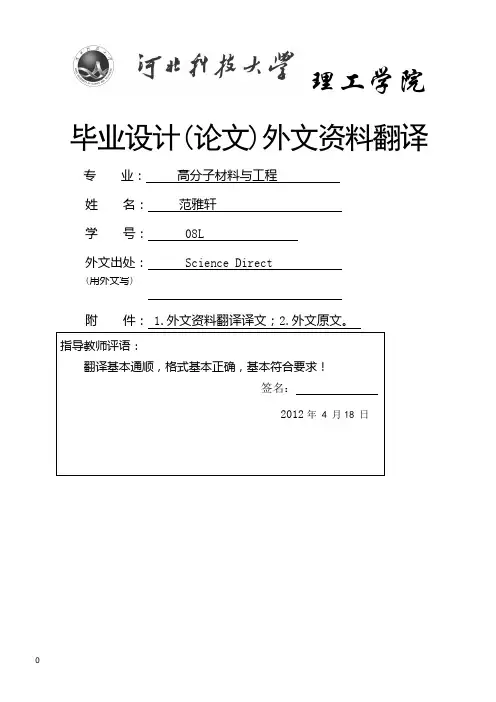
理工学院毕业设计(论文)外文资料翻译专业:高分子材料与工程姓名:范雅轩学号: 08L外文出处: Science Direct(用外文写)附件: 1.外文资料翻译译文;2.外文原文。
指导教师评语:翻译基本通顺,格式基本正确,基本符合要求!签名:2012年 4 月18 日附件1:外文资料翻译译文基于因特网的注塑模具智能设计系统摘要互联网和信息技术在近几年的飞速发展为支持促进不同地理分布企业的协同产品的开发提供了一个解决方案。
通过开发基于因特网的协同产品开发模块的模具设计系统,我们可以找到促进注塑模具合作发展的行之有效的工具。
本文介绍了注塑模具基于因特网的智能设计的一种原型。
该系统的架构包括一个嵌入网络环境的交互式KB模具设计系统。
采用人工智能技术的Java功能的方法可用来发展网络交互式计算机辅助设计系统。
在这个系统中,计算模块、知识模块和模具特点图形生成模块的功能集成在一个交互式模具CAD技术框架。
该系统的知识基础是通过互动过程访问模具设计师而获得,这样也可以使他们自己的智慧和经验纳入总的模具设计。
该方法加快了设计进程,也促进了设计的标准化,从而加快了模具制造的的速度。
我们用一个实际的案例研究来说明基于互联网的模具设计系统(具体)操作。
关键词:因特网基于知识的专家系统注塑模具设计合作1、简介塑料,这是当今时代最多才多艺的一种材料,被广泛应用在世界各地的许多产品中。
由于它能够生产复杂形状的塑料部件,具有良好的尺寸精度和很短的生产周期,今天注射成型已成为塑料工业中用于制造塑料零部件最重要的工艺过程。
然而,由于全球化的市场,短生命周期产品的开发,增加产品多样化、高要求的产品质量,当前塑料工业正处在巨大的压力下。
为了满足上述要求,这种贸易采用各种先进的技术是非常重要的,这些技术包括信息和网络技术、计算机辅助集成技术、并行工程、人工智能等等,有效帮助了注射模压产品的发展。
在注塑成型中,为满足产品质量和高效的处理模具的设计是至关重要的。

天津科技大学本科生毕业设计(论文)外文资料翻译学院:材料科学与化学工程学院专业:高分子材料与工程姓名:阮孝顺学号:10032411指导教师(签名):2014年3月15日基底机械附着防水体系ACC板适宜性的确认及其高风压下的强度Michal Bartko a, Hiroyuki Miyauchi a,*, Kyoji Tanaka ba忠南大学,305-764,大田,南韩b日本东京工业大学,226-8503,神奈川县,日本2012年9月7日收到,2013年5月9日收到修改稿,2013年5月19日接受,2013年6月19日发表【摘要】受到强风的影响,机械连接防水体系的蒸气压混凝土板(AAC)的可靠性需要验证。
通过静态和动态拉伸试验研究AAC面板紧固件的优点。
对最常用的机械和化学紧固件的优点和AAC断裂类型进行测试观察。
静态强度值介于2.0至5.0kN之间,动态强度下降范围在1.5到2.2kN之间。
而且,我们创造性的应用了弹性粘合剂来代替常用的环氧树脂从而广泛的消除了ACC断裂。
我们使用专门设计和生产的恒定负载型动态测试仪,检查完整的机械连接的防水体系的特征。
我们测试了两种聚氯乙烯(PVC)卷材的类型和两种不同的卷材和圆盘连接方法。
重复实验,直到失败的次数高达100,000次,并记录在相同强度的强风下实际屋顶发生的断裂类型。
也发现了紧固件的动态强度和完全防水体系之间的关系,证明了AAC面板有足够承载力能够作为机械连接防水体系的基底,也探究出了确定紧固件最大间距的方法。
2013年爱思唯尔公司保留所有权。
【关键词】:机械连接防水体系;AAC镶基板;阻力风;静态和动态测试;断口模式;体系设计方法2013年爱思唯尔公司保留所有权。
1.前言机械连接防水体系是一种干式防水体系,有几个优势,比如不受裂缝和联合移动的影响。
该防水体系适用于多种类型的基板,安装简单容易,可以方便的修复,在技术上和经济上可行。
因此,该体系在日本和全球的使用量正在增长。
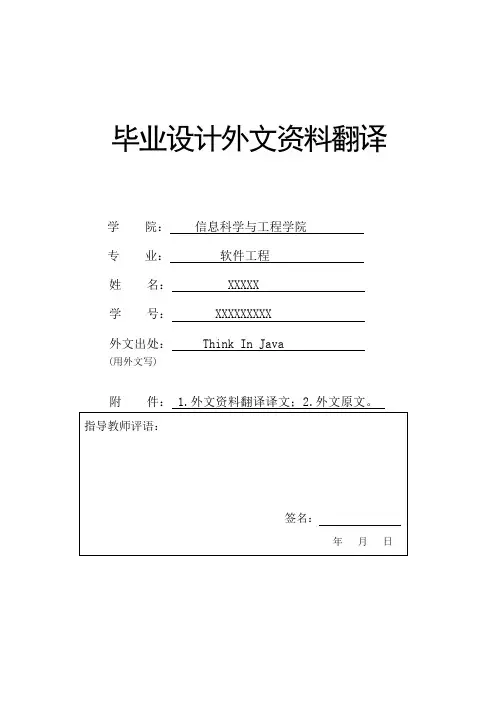
毕业设计外文资料翻译学院:信息科学与工程学院专业:软件工程姓名: XXXXX学号: XXXXXXXXX外文出处: Think In Java (用外文写)附件: 1.外文资料翻译译文;2.外文原文。
附件1:外文资料翻译译文网络编程历史上的网络编程都倾向于困难、复杂,而且极易出错。
程序员必须掌握与网络有关的大量细节,有时甚至要对硬件有深刻的认识。
一般地,我们需要理解连网协议中不同的“层”(Layer)。
而且对于每个连网库,一般都包含了数量众多的函数,分别涉及信息块的连接、打包和拆包;这些块的来回运输;以及握手等等。
这是一项令人痛苦的工作。
但是,连网本身的概念并不是很难。
我们想获得位于其他地方某台机器上的信息,并把它们移到这儿;或者相反。
这与读写文件非常相似,只是文件存在于远程机器上,而且远程机器有权决定如何处理我们请求或者发送的数据。
Java最出色的一个地方就是它的“无痛苦连网”概念。
有关连网的基层细节已被尽可能地提取出去,并隐藏在JVM以及Java的本机安装系统里进行控制。
我们使用的编程模型是一个文件的模型;事实上,网络连接(一个“套接字”)已被封装到系统对象里,所以可象对其他数据流那样采用同样的方法调用。
除此以外,在我们处理另一个连网问题——同时控制多个网络连接——的时候,Java内建的多线程机制也是十分方便的。
本章将用一系列易懂的例子解释Java的连网支持。
15.1 机器的标识当然,为了分辨来自别处的一台机器,以及为了保证自己连接的是希望的那台机器,必须有一种机制能独一无二地标识出网络内的每台机器。
早期网络只解决了如何在本地网络环境中为机器提供唯一的名字。
但Java面向的是整个因特网,这要求用一种机制对来自世界各地的机器进行标识。
为达到这个目的,我们采用了IP(互联网地址)的概念。
IP以两种形式存在着:(1) 大家最熟悉的DNS(域名服务)形式。
我自己的域名是。
所以假定我在自己的域内有一台名为Opus的计算机,它的域名就可以是。
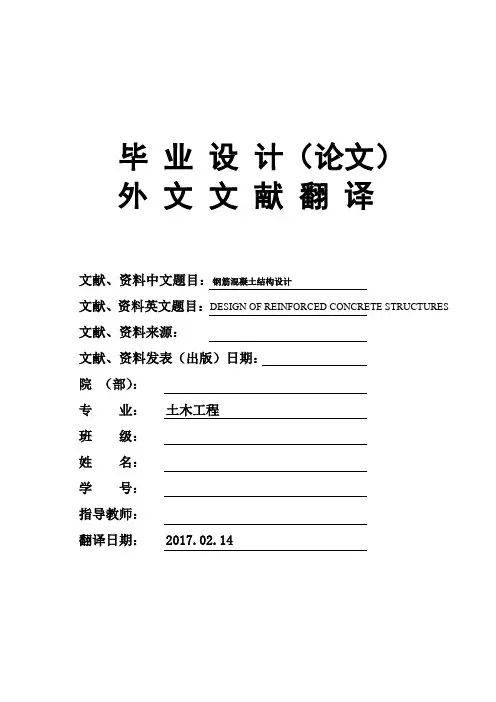
毕业设计(论文)外文文献翻译文献、资料中文题目:钢筋混凝土结构设计文献、资料英文题目:DESIGN OF REINFORCED CONCRETE STRUCTURES 文献、资料来源:文献、资料发表(出版)日期:院(部):专业:土木工程班级:姓名:学号:指导教师:翻译日期: 2017.02.14毕业设计(论文)外文参考资料及译文译文题目:DESIGN OF REINFORCED CONCRETE STRUCTURES原文:DESIGN OF REINFORCED CONCRETESTRUCTURES1. BASIC CONCERPTS AND CHARACERACTERISTICS OF REINFORCED CONCRETEPlain concrete is formed from hardened mixture of cement, water , fine aggregate , coarse aggregate (crushed stone or gravel ) , air and often other admixtures . The plastic mix is placed and consolidated in the formwork, then cured to accelerate of the chemical hydration of hen cement mix and results in a hardened concrete. It is generally known that concrete has high compressive strength and low resistance to tension. Its tensile strength is approximatelyone-tenth of its compressive strength. Consequently, tensile reinforcement in the tension zone has to be provided to supplement the tensile strength of the reinforced concrete section.For example, a plain concrete beam under a uniformly distributed load q is shown in Fig .1.1(a), when the distributed load increases and reaches a value q=1.37KN/m , the tensile region at the mid-span will be cracked and the beam will fail suddenly . A reinforced concrete beam if the same size but has to steel reinforcing bars (2φ16) embedded at the bottom under a uniformly distributed load q is shown in Fig.1.1(b). The reinforcing bars take up the tension there after the concrete is cracked. When the load q is increased, the width of the cracks, the deflection and thestress of steel bars will increase . When the steel approaches the yielding stress ƒy , thedeflection and the cracked width are so large offering some warning that the compression zone . The failure load q=9.31KN/m, is approximately 6.8 times that for the plain concrete beam.Concrete and reinforcement can work together because there is a sufficiently strong bond between the two materials, there are no relative movements of the bars and the surrounding concrete cracking. The thermal expansion coefficients of the two materials are 1.2×10-5K-1 for steel and 1.0×10-5~1.5×10-5K-1 for concrete .Generally speaking, reinforced structure possess following features :Durability .With the reinforcing steel protected by the concrete , reinforced concreteFig.1.1Plain concrete beam and reinforced concrete beamIs perhaps one of the most durable materials for construction .It does not rot rust , and is not vulnerable to efflorescence .(2)Fire resistance .Both concrete an steel are not inflammable materials .They would not be affected by fire below the temperature of 200℃when there is a moderate amount of concrete cover giving sufficient thermal insulation to the embedded reinforcement bars.(3)High stiffness .Most reinforced concrete structures have comparatively large cross sections .As concrete has high modulus of elasticity, reinforced concrete structures are usuallystiffer than structures of other materials, thus they are less prone to large deformations, This property also makes the reinforced concrete less adaptable to situations requiring certainflexibility, such as high-rise buildings under seismic load, and particular provisions have to be made if reinforced concrete is used.(b)Reinfoced concrete beam(4)Locally available resources. It is always possible to make use of the local resources of labour and materials such as fine and coarse aggregates. Only cement and reinforcement need to be brought in from outside provinces.(5)Cost effective. Comparing with steel structures, reinforced concrete structures are cheaper.(6)Large dead mass, The density of reinforced concrete may reach2400~2500kg/pare with structures of other materials, reinforced concrete structures generally have a heavy dead mass. However, this may be not always disadvantageous, particularly for those structures which rely on heavy dead weight to maintain stability, such as gravity dam and other retaining structure. The development and use of light weight aggregate have to a certain extent make concrete structure lighter.(7)Long curing period.. It normally takes a curing period of 28 day under specified conditions for concrete to acquire its full nominal strength. This makes the progress of reinforced concrete structure construction subject to seasonal climate. The development of factory prefabricated members and investment in metal formwork also reduce the consumption of timber formwork materials.(8)Easily cracked. Concrete is weak in tension and is easily cracked in the tension zone. Reinforcing bars are provided not to prevent the concrete from cracking but to take up the tensile force. So most of the reinforced concrete structure in service is behaving in a cracked state. This is an inherent is subjected to a compressive force before working load is applied. Thus the compressed concrete can take up some tension from the load.2. HISTOEICAL DEVELPPMENT OF CONCRETE STRUCTUREAlthough concrete and its cementitious(volcanic) constituents, such as pozzolanic ash, have been used since the days of Greek, the Romans, and possibly earlier ancient civilization, the use of reinforced concrete for construction purpose is a relatively recent event, In 1801, F. Concrete published his statement of principles of construction, recognizing the weakness if concrete in tension, The beginning of reinforced concrete is generally attributed to Frenchman J. L. Lambot, who in 1850 constructed, for the first time, a small boat with concrete for exhibition in the 1855 World’s Fair in Paris. In England, W. B. Wilkinson registered a patent for reinforced concrete l=floor slab in 1854.J.Monier, a French gardener used metal frames as reinforcement to make garden plant containers in 1867. Before 1870, Monier had taken a series of patents to make reinforcedconcrete pipes, slabs, and arches. But Monier had no knowledge of the working principle of this new material, he placed the reinforcement at the mid-depth of his wares. Then little construction was done in reinforced concrete. It is until 1887, when the German engineers Wayss and Bauschinger proposed to place the reinforcement in the tension zone, the use of reinforced concrete as a material of construction began to spread rapidly. In1906, C. A. P. Turner developed the first flat slab without beams.Before the early twenties of 20th century, reinforced concrete went through the initial stage of its development, Considerable progress occurred in the field such that by 1910 the German Committee for Reinforced Concrete, the Austrian Concrete Committee, the American Concrete Institute, and the British Concrete Institute were established. Various structural elements, such as beams, slabs, columns, frames, arches, footings, etc. were developed using this material. However, the strength of concrete and that of reinforcing bars were still very low. The common strength of concrete at the beginning of 20th century was about 15MPa in compression, and the tensile strength of steel bars was about 200MPa. The elements were designed along the allowable stresses which was an extension of the principles in strength of materials.By the late twenties, reinforced concrete entered a new stage of development. Many buildings, bridges, liquid containers, thin shells and prefabricated members of reinforced concrete were concrete were constructed by 1920. The era of linear and circular prestressing began.. Reinforced concrete, because of its low cost and easy availability, has become the staple material of construction all over the world. Up to now, the quality of concrete has been greatly improved and the range of its utility has been expanded. The design approach has also been innovative to giving the new role for reinforced concrete is to play in the world of construction.The concrete commonly used today has a compressive strength of 20~40MPa. For concrete used in pre-stressed concrete the compressive strength may be as high as 60~80MPa. The reinforcing bars commonly used today has a tensile strength of 400MPa, and the ultimate tensile strength of prestressing wire may reach 1570~1860Pa. The development of high strength concrete makes it possible for reinforced concrete to be used in high-rise buildings, off-shore structures, pressure vessels, etc. In order to reduce the dead weight of concrete structures, various kinds of light concrete have been developed with a density of 1400~1800kg/m3. With a compressive strength of 50MPa, light weight concrete may be used in load bearing structures. One of the best examples is the gymnasium of the University of Illinois which has a span of 122m and is constructed of concrete with a density of 1700kg/m3. Another example is the two 20-story apartment houses at the Xi-Bian-Men in Beijing. The walls of these two buildings are light weight concrete with a density of 1800kg/m3.The tallest reinforced concrete building in the world today is the 76-story Water Tower Building in Chicago with a height of 262m. The tallest reinforced concrete building in China today is the 63-story International Trade Center in GuangZhou with a height a height of 200m. The tallest reinforced concrete construction in the world is the 549m high International Television Tower in Toronto, Canada. He prestressed concrete T-section simply supported beam bridge over the Yellow River in Luoyang has 67 spans and the standard span length is 50m.In the design of reinforced concrete structures, limit state design concept has replaced the old allowable stresses principle. Reliability analysis based on the probability theory has very recently been introduced putting the limit state design on a sound theoretical foundation. Elastic-plastic analysis of continuous beams is established and is accepted in most of the design codes. Finite element analysis is extensively used in the design of reinforced concrete structures and non-linear behavior of concrete is taken into consideration. Recent earthquake disasters prompted the research in the seismic resistant reinforced of concrete structures. Significant results have been accumulated.3. SPECIAL FEATURES OF THE COURSEReinforced concrete is a widely used material for construction. Hence, graduates of every civil engineering program must have, as a minimum requirement, a basic understanding of the fundamentals of reinforced concrete.The course of Reinforced Concrete Design requires the prerequisite of Engineering Mechanics, Strength of Materials, and some if not all, of Theory of Structures, In all these courses, with the exception of Strength of Materials to some extent, a structure is treated of in the abstract. For instance, in the theory of rigid frame analysis, all members have an abstract EI/l value, regardless of what the act value may be. But the theory of reinforced concrete is different, it deals with specific materials, concrete and steel. The values of most parameters must be determined by experiments and can no more be regarded as some abstract. Additionally, due to the low tensile strength of concrete, the reinforced concrete members usually work with cracks, some of the parameters such as the elastic modulus I of concrete and the inertia I of section are variable with the loads.The theory of reinforced concrete is relatively young. Although great progress has been made, the theory is still empirical in nature in stead of rational. Many formulas can not be derived from a few propositions, and may cause some difficulties for students. Besides, due to the difference in practice in different countries, most countries base their design methods on their own experience and experimental results. Consequently, what one learns in one country may be different in another country. Besides, the theory is still in a stage of rapid。
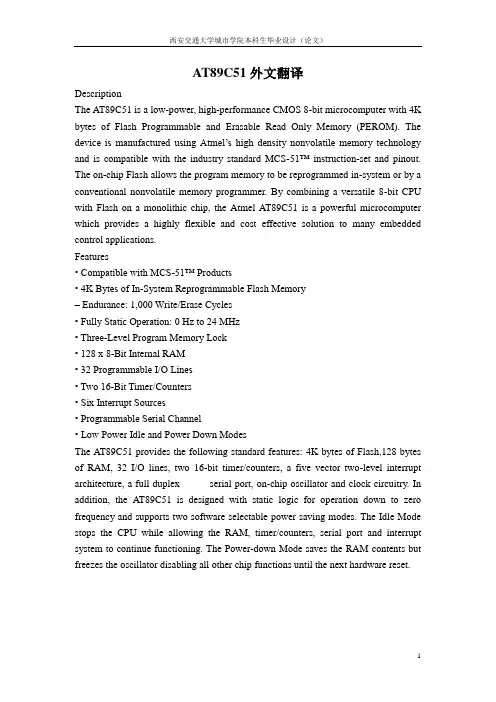
AT89C51外文翻译DescriptionThe AT89C51 is a low-power, high-performance CMOS 8-bit microcomputer with 4K bytes of Flash Programmable and Erasable Read Only Memory (PEROM). The device is manufactured using Atmel’s high density nonvolatile memory technology and is compatible with the industry standard MCS-51™ instruction-set and pinout. The on-chip Flash allows the program memory to be reprogrammed in-system or by a conventional nonvolatile memory programmer. By combining a versatile 8-bit CPU with Flash on a monolithic chip, the Atmel A T89C51 is a powerful microcomputer which provides a highly flexible and cost effective solution to many embedded control applications.Features• Compatible with MCS-51™ Products• 4K Bytes of In-System Reprogrammable Flash Memory– Endurance: 1,000 Write/Erase Cycles• Fully Static Operation: 0 Hz to 24 MHz• Three-Level Program Memory Lock• 128 x 8-Bit Internal RAM• 32 Programmable I/O Lines• Two 16-Bit Timer/Counters• Six Interrupt Sources• Programmable Serial Channel• Low Power Idle and Power Down ModesThe AT89C51 provides the following standard features: 4K bytes of Flash,128 bytes of RAM, 32 I/O lines, two 16-bit timer/counters, a five vector two-level interrupt architecture, a full duplex serial port, on-chip oscillator and clock circuitry. In addition, the AT89C51 is designed with static logic for operation down to zero frequency and supports two software selectable power saving modes. The Idle Mode stops the CPU while allowing the RAM, timer/counters, serial port and interrupt system to continue functioning. The Power-down Mode saves the RAM contents but freezes the oscillator disabling all other chip functions until the next hardware reset.VCCSupply voltage.GNDGround.Port 0Port 0 is an 8-bit open-drain bi-directional I/O port. As an output port, each pin can sink eight TTL inputs. When 1s are written to port 0 pins, the pins can be used as high-impedance inputs.Port 0 may also be configured to be the multiplexed low-order address/data bus during accesses to external program and data memory. In this mode P0 has internal pullups. Port 0 also receives the code bytes during Flash programming, and outputs the code bytes during program verification. External pullups are required during program verification.Port 1Port 1 is an 8-bit bi-directional I/O port with internal pullups.The Port 1 output buffers can sink/source four TTL inputs.When 1s are written to Port 1 pins they are pulled high by the internal pullups and can be used as inputs. As inputs,Port 1 p ins that are externally being pulled low will source current (IIL) because of the internal pullups.Port 1 also receives the low-order address bytes during Flash programming and verification.Port 2Port 2 is an 8-bit bi-directional I/O port with internal pullups.The Port 2 output buffers can sink/source four TTL inputs.When 1s are written to Port 2 pins they are pulled high by the internal pullups and can be used as inputs. As inputs,Port 2 pins that are externally being pulled low will source current (IIL) because of the internal pullups. Port 2 emits the high-order address byte during fetches from external program memory and during accesses to external data memory that use 16-bit addresses (MOVX @DPTR). In this application, it uses strong internal pullups when emitting 1s. During accesses to external data memory that use 8-bit addresses (MOVX @ RI), Port 2 emits the contents of the P2 Special Function Register. Port 2 also receives the high-order address bits and some control signals during Flash programming and verification.Port 3Port 3 is an 8-bit bi-directional I/O port with internal pullups. The Port 3 output buffers can sink/source four TTL inputs.When 1s are written to Port 3 pins they arepulled high by the internal pullups and can be used as inputs. As inputs,Port 3 pins that are externally being pulled low will source current (IIL) because of the pullups. Port 3 also serves the functions of various special features of the AT89C51 as listed below:Port 3 also receives some control signals for Flash programming and verification. RSTReset input. A high on this pin for two machine cycles while the oscillator is running resets the device.ALE/PROGAddress Latch Enable output pulse for latching the low byte of the address during accesses to external memory. This pin is also the program pulse input (PROG) during Flash programming. In normal operation ALE is emitted at a constant rate of 1/6 the oscillator frequency, and may be used for external timing or clocking purposes. Note, however, that one ALE pulse is skipped during each access to external Data Memory.If desired, ALE operation can be disabled by setting bit 0 of SFR location 8EH. With the bit set, ALE is active only during a MOVX or MOVC instruction. Otherwise, the pin is weakly pulled high. Setting the ALE-disable bit has no effect if the microcontroller is in external execution mode.PSENProgram Store Enable is the read strobe to external program memory. When the AT89C51 is executing code from external program memory, PSEN is activated twice each machine cycle, except that two PSEN activations are skipped during each access to external data memory.EA/VPPExternal Access Enable. EA must be strapped to GND in order to enable the device to fetch code from external program memory locations starting at 0000H up toFFFFH.Note, however, that if lock bit 1 is programmed, EA will be internally latched on reset. EA should be strapped to VCC for internal program executions.This pin also receives the 12-volt programming enable voltage (VPP) during Flash programming, for parts that require 12-volt VPP.XTAL1Input to the inverting oscillator amplifier and input to the internal clock operating circuit.XTAL2Output from the inverting oscillator amplifier.Oscillator CharacteristicsXTAL1 and XTAL2 are the input and output, respectively,of an inverting amplifier which can be configured for use as an on-chip oscillator, as shown in Figure 1. Either a quartz crystal or ceramic resonator may be used. To drive the device from an external clock source, XTAL2 should be left unconnected while XTAL1 is driven as shown in Figure 2.There are no requirements on the duty cycle of the external clock signal, since the input to the internal clocking circuitry is through a divide-by-two flip-flop, but minimum and maximum voltage high and low time specifications must be observed.Idle ModeIn idle mode, the CPU puts itself to sleep while all the on-chip peripherals remain active. The mode is invoked by software. The content of the on-chip RAM and all the special functions registers remain unchanged during this mode. The idle mode can be terminated by any enabled interrupt or by a hardware reset. It should be noted that when idle is terminated by a hard ware reset, the device normally resumes program execution, from where it left off, up to two machine cycles before the internal reset algorithm takes control. On-chip hardware inhibits access to internal RAM in this event, but access to the port pins is not inhibited. To eliminate the possibility of an unexpected write to a port pin when Idle is terminated by reset, the instruction following the one that invokes Idle should not be one that writes to a port pin or to external memory.Figure 1. Oscillator ConnectionsNote: C1, C2 = 30 pF ± 10 pF for Crystals= 40 pF ± 10 pF for Ceramic ResonatorsFigure 2. External Clock Drive ConfigurationPower-down ModeIn the power-down mode, the oscillator is stopped, and the instruction that invokes power-down is the last instruction executed. The on-chip RAM and Special Function Registers retain their values until the power-down mode is terminated. The only exit from power-down is a hardware reset. Reset redefines the SFRs but does not change the on-chip RAM. The reset should not be activated before VCC is restored to its normal operating level and must be held active long enough to allow the oscillator to restart and stabilize.Program Memory Lock BitsOn the chip are three lock bits which can be left unprogrammed (U) or can be programmed (P) to obtain the additional features listed in the table below.When lock bit 1 is programmed, the logic level at the EA pin is sampled and latched during reset.If the device is powered up without a reset, the latch initializes to a random value, and holds that value until reset is activated. It is necessary that the latched value of EA be in agreement with the current logic level at that pin in order for the device to function properly.Programming the FlashThe AT89C51 is normally shipped with the on-chip Flash memory array in the erased state (that is, contents = FFH)and ready to be programmed. The programming interface accepts either a high-voltage (12-volt) or a low-voltage (VCC) program enable signal. The low-voltage programming mode provides a convenient way to program the AT89C51 inside t he user’s system, while the high-voltage programming mode is compatible with conventional thirdparty Flash or EPROM programmers.The AT89C51 is shipped with either the high-voltage or low-voltage programming mode enabled. The respective top-side marking and device signature codes are listed in the following table.The AT89C51 code memory array is programmed byte-by-byte in either programming mode. To program any non-blank byte in the on-chip Flash Memory, the entire memory must be erased using the Chip Erase Mode. Programming Algorithm: Before programming the A T89C51, the address, data and control signals should be set up according to the Flash programming mode table and Figures 3 and 4. To program the AT89C51, take the following steps.1. Input the desired memory location on the address lines.2. Input the appropriate data byte on the data lines.3. Activate the correct combination of control signals.4. Raise EA/VPP to 12V for the high-voltage programming mode.5. Pulse ALE/PROG once to program a byte in the Flash array or the lock bits. The byte-write cycle is self-timedand typically takes no more than 1.5 ms. Repeat steps 1 through 5, changing the address and data for the entire array or until the end of the object file is reached.Data Polling: The AT89C51 features Data Polling to indicate the end of a write cycle. During a write cycle, anattempted read of the last byte written will result in the complement of the written datum on PO.7. Once the write cycle has been completed, true data are valid on all outputs, and the next cycle may begin. Data Polling may begin any time after a write cycle has been initiated.Ready/Busy: The progress of byte programming can also be monitored by the RDY/BSY output signal. P3.4 is pulled low after ALE goes high during programming to indicate BUSY. P3.4 is pulled high again when programming is done to indicate READY.Program V erify: If lock bits LB1 and LB2 have not been programmed, the programmed code data can be read back via the address and data lines for verificatio n. The lock bits cannot be verified directly. V erification of the lock bits is achieved by observing that their features are enabled.Chip Erase: The entire Flash array is erased electrically by using the proper combination of control signals and by holding ALE/PROG low for 10 ms. The code array is written with all ―1‖s. The chip erase operation must be executed before the code memory can be re-programmed.Reading the Signature Bytes: The signature bytes are read by the same procedure as a normal verification of locations 030H, 031H, and 032H, except that P3.6 and P3.7 must be pulled to a logic low. The values returned are as follows.(030H) = 1EH indicates manufactured by Atmel(031H) = 51H indicates 89C51(032H) = FFH indicates 12V programming(032H) = 05H indicates 5V programmingProgramming InterfaceEvery code byte in the Flash array can be written and the entire array can be erased by using the appropriate combination of control signals. The write operation cycle is selftimed and once initiated, will automatically time itself to completion.All major programming vendors offer worldwide support for the Atmelmicrocontroller series. Please contact your local programming vendor for the appropriate software revision.Flash Programming and V erification Waveforms - High-voltage Mode (VPP = 12V)Flash Programming and V erification Waveforms - Low-voltage Mode (VPP = 5V)Flash Programming and Verification Characteristics TA = 0°C to 70°C, VCC = 5.0 ±10%Absolute Maximum Ratings**NOTICE: Str esses beyond those listed under ―Absolute Maximum Ratings‖ may cause permanent damage to the device. This is a stress rating only and functional operation of the device at these or any other conditions beyond those indicated in the operational sections of this specification is not implied. Exposure to absolute maximum rating conditions for extended periods may affect device reliability.DC CharacteristicsTA = -40°C to 85°C, VCC = 5.0V ±20% (unless otherwise noted)Notes: 1. Under steady state (non-transient) conditions, IOL must be externally limited as follows:Maximum IOL per port pin: 10 mAMaximum IOL per 8-bit port: Port 0: 26 mAPorts 1, 2, 3: 15 mAMaximum total IOL for all output pins: 71 mAIf IOL exceeds the test condition, VOL may exceed the related specification. Pins arenot guaranteed to sink current greater than the listed test conditions.2. Minimum VCC for Power-down is 2V.AC CharacteristicsUnder operating conditions, load capacitance for Port 0, ALE/PROG, and PSEN = 100 pF; load capacitance for all other outputs = 80 pF.External Program and Data Memory CharacteristicsExternal Program Memory Read CycleExternal Data Memory Read CycleExternal Data Memory Write CycleExternal Clock Drive WaveformsExternal Clock DriveSerial Port Timing: Shift Register Mode Test Conditions (VCC = 5.0 V ±20%; Load Capacitance = 80 pF)Shift Register Mode Timing WaveformsAC Testing Input/Output Waveforms(1)Note: 1. AC Inputs during testing are driven at VCC - 0.5V for a logic 1 and 0.45V for a logic 0. Timing measurements are made at VIH min. for a logic 1 and VIL max. for a logic 0.Float Waveforms(1)Note: 1. For timing purposes, a port pin is no longer floating when a 100mV change from load voltage occurs. A port pin begins to float when 100mV change from the loaded VOH/VOL level occurs.AT89C51中文原文AT89C51是美国ATMEL公司生产的低电压,高性能CMOS8位单片机,片内含4k bytes的可反复擦写的只读程序存储器(PEROM)和128 bytes的随机存取数据存储器(RAM),器件采用A TMEL公司的高密度、非易失性存储技术生产,兼容标准MCS-51指令系统,片内置通用8位中央处理器(CPU)和Flash存储单元,功能强大AT89C51单片机可为您提供许多高性价比的应用场合,可灵活应用于各种控制领域。
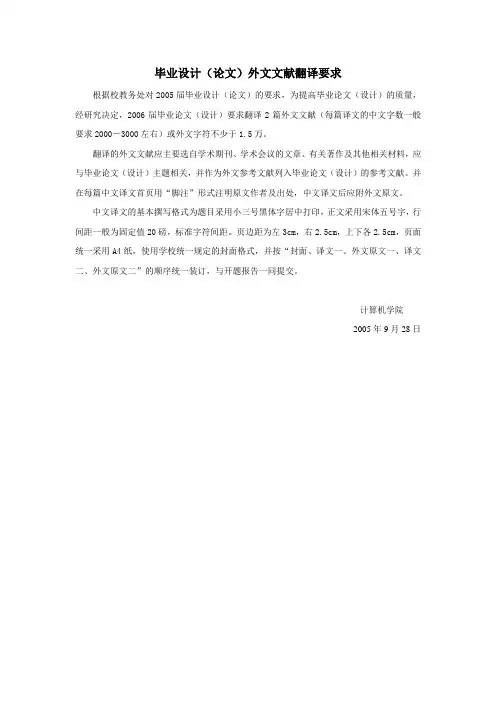
毕业设计(论文)外文文献翻译要求
根据校教务处对2005届毕业设计(论文)的要求,为提高毕业论文(设计)的质量,经研究决定,2006届毕业论文(设计)要求翻译2篇外文文献(每篇译文的中文字数一般要求2000-3000左右)或外文字符不少于1.5万。
翻译的外文文献应主要选自学术期刊、学术会议的文章、有关著作及其他相关材料,应与毕业论文(设计)主题相关,并作为外文参考文献列入毕业论文(设计)的参考文献。
并在每篇中文译文首页用“脚注”形式注明原文作者及出处,中文译文后应附外文原文。
中文译文的基本撰写格式为题目采用小三号黑体字居中打印,正文采用宋体五号字,行间距一般为固定值20磅,标准字符间距。
页边距为左3cm,右2.5cm,上下各2.5cm,页面统一采用A4纸,使用学校统一规定的封面格式,并按“封面、译文一、外文原文一、译文二、外文原文二”的顺序统一装订,与开题报告一同提交。
计算机学院
2005年9月28日
杭州电子科技大学
毕业设计(论文)外文文献翻译
毕业设计(论文)题目
翻译(1)题目
翻译(2)题目
学院
专业
姓名
班级
学号
指导教师。
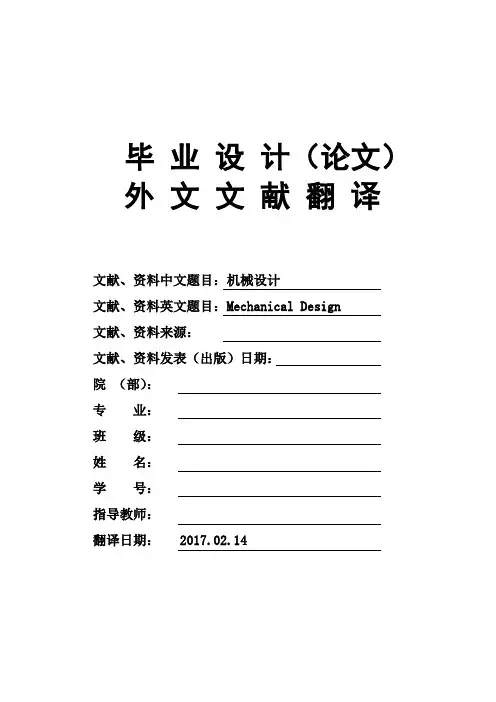
毕业设计(论文)外文文献翻译文献、资料中文题目:机械设计文献、资料英文题目:Mechanical Design文献、资料来源:文献、资料发表(出版)日期:院(部):专业:班级:姓名:学号:指导教师:翻译日期: 2017.02.14外文资料翻译译文机械设计摘要:机器是由机械装置和其它组件组成的。
它是一种用来转换或传递能量的装置,例如:发动机、涡轮机、车辆、起重机、印刷机、洗衣机、照相机和摄影机等。
许多原则和设计方法不但适用于机器的设计,也适用于非机器的设计。
术语中的“机械装置设计”的含义要比“机械设计”的含义更为广泛一些,机械装置设计包括机械设计。
在分析运动及设计结构时,要把产品外型以及以后的保养也要考虑在机械设计中。
在机械工程领域中,以及其它工程领域中,所有这些都需要机械设备,比如:开关、凸轮、阀门、船舶以及搅拌机等。
关键词:设计流程设计规则机械设计设计流程设计开始之前就要想到机器的实际性,现存的机器需要在耐用性、效率、重量、速度,或者成本上得到改善。
新的机器必需具有以前机器所能执行的功能。
在设计的初始阶段,应该允许设计人员充分发挥创造性,不要受到任何约束。
即使产生了许多不切实际的想法,也会在设计的早期,即在绘制图纸之前被改正掉。
只有这样,才不致于阻断创新的思路。
通常,还要提出几套设计方案,然后加以比较。
很有可能在这个计划最后决定中,使用了某些不在计划之内的一些设想。
一般的当外型特点和组件部分的尺寸特点分析得透彻时,就可以全面的设计和分析。
接着还要客观的分析机器性能的优越性,以及它的安全、重量、耐用性,并且竞争力的成本也要考虑在分析结果之内。
每一个至关重要的部分要优化它的比例和尺寸,同时也要保持与其它组成部分相协调。
也要选择原材料和处理原材料的方法。
通过力学原理来分析和实现这些重要的特性,如那些静态反应的能量和摩擦力的最佳利用,像动力惯性、加速动力和能量;包括弹性材料的强度、应力和刚度等材料的物理特性,以及流体润滑和驱动器的流体力学。
毕业设计(论文)外文文献翻译文献、资料中文题目:智能照明控制系统文献、资料英文题目:Intelligent lighting control system 文献、资料来源:文献、资料发表(出版)日期:院(部):专业:自动化班级:姓名:学号:指导教师:翻译日期: 2017.02.14本科毕业设计(外文翻译)题目基于PWM的智能多功能台灯设计Intelligent lighting control systemAbstract:Intelligent lighting control system the main aim is to save energy, smart lighting control system with a variety of "pre-set" control mode and control components, at different times on different degrees of illumination for accurate set-up and rational management of energy-saving. This automatic adjustment of the illumination means, take full advantage of the natural outdoor light, only when necessary when the lamp or light to the required brightness, use the least energy toensure that the required illumination level, energy-saving effect is very clear, usually ranging from more than 30%.Keywords: Intelligent lighting control system bus-type star-shaped structure1 The advantages of the use of the intelligent lighting control system1.1 Good energy saving effectIntelligent lighting control system using the main purpose is to save energy, smart lighting control system with a variety of "pre-set" control mode and control components, at different times on different degrees of illumination for accurate set-up and rational management of energy-saving. This automatic adjustment of the illumination means, take full advantage of the natural outdoor light, only when necessary when the lamp or light to the required brightness, use the least energy to ensure that the required illumination level, energy-saving effect is very clear, usually ranging from more than 30%. In addition, the intelligent lighting control system for fluorescent lamp dimming control, etc., due to the use of a fluorescent active tunable filter electronic ballast technology and reduce the harmonic content, to improve the power factor and reduce the low-voltage reactive power loss.1.2 To extend the life span of light sourceLight source can not only extend the life savings, but also significantly reduce the workload of lamp replacement, reducing the operating costs of lighting systems, management and maintenance becomes simple. Both the thermal radiation source, or gas discharge light source, voltage fluctuations are a major cause of light damage. Therefore, the effective suppression of the fluctuations in voltage can extend the life of light sources. Intelligent lighting control system can successfully suppress the surge voltage power grid, but also have a voltage limit and the conjugate stream functions of filtering, to avoid over-voltage and under-voltage damage to the light. The use of soft-start and soft turn-off technology, to avoid the impact of currentdamage to the light. Through this method, the light source to extend the life span of usually 2 to 4 times.1.3 To improve the working environment improve efficiencyGood working environment is to improve the efficiency of a necessary condition. Good design and reasonable choice of light source, lamps and lighting quality control systems, can improve the quality of lighting. Intelligent lighting control system dimming control panel module to replace the traditional lighting of the level switch control is an effective way to control the overall room illumination value, thereby enhancing the uniformity of illumination. At the same time, this control method used in electrical components have also solved the stroboscopic effect, will not create uncomfortable, confused, feeling eyestrain.1.4 To achieve a variety of lighting effectsA wide range of lighting control, the same building can have a variety of artistic effect, for a lot of construction hyperchromic. Modern buildings, lighting is not simply to meet people on the visual effect of light and shade, they should have control of a variety of programs to make buildings more vivid, more artistic, giving a wealth of visual effects and aesthetics. As an example of a project, building the exhibition hall, lecture hall, lobby, atrium, etc., if with intelligent lighting control system, according to different times, different uses, different effects, using the corresponding pre-set scene control, can achieve the wealth of artistic effect.1.5 Facilitate the management of maintenanceIntelligent lighting control system for the control of lighting based on the automatic control of modular-based, supplemented by manual control, preset lighting scenes to the parameters stored in the EPROM Digital, these information is very convenient to set up and replaced, so that building lighting management and maintenance easier.1.6 Have a high economic rate of returnOur reference point for the Shanghai region, from energy-saving lights and provincial estimates of the two made a come to this conclusion: with three to five years, the owner can recover the basic intelligent lighting control system to increase the total costs. Intelligent lighting control system can improve the environment and improve employee productivity and reduce maintenance and management costs, but also for the owners to save a substantial amount of costs.2 Intelligent lighting control system componentsWe know that the intelligent lighting control system of building control system is onlyone part of the. If you want to focus on the various control systems to the control center to control, then the control system must have the standard communication interface and protocol version. Although such a system integration is feasible in theory, but it is very difficult to put into practice. Thus, in engineering, intelligent management of our building a distributed system, distributed, that is relatively independent of each control subsystem, self-contained, the implementation of specific control, intelligent building management system control subsystem of the relative independence, self-contained, the implementation of specific control, intelligent building management system from the control subsystem is a signal collection and monitoring role. At present, the intelligent lighting control system in accordance with sub-network topology, the following two forms, namely, bus and star-shaped structure-based hybrid. Both forms have the characteristics of a number of bus more flexibility, easy expansion, control of relative independence, lower costs; mixed some high reliability, fault diagnosis and rule out the simple, easy access to the agreement, transfer rate higher. Engineering design, we consider the building of intelligent lighting control system as an independent subsystem, use of international standards and agreements of the communication interface text, into the intelligent building management systems. Intelligent lighting control system uses a distributed, distribution-based approach,that is, the dimming control unit is relativelyindependent, self-contained,non-interfering, through centralized management and information interfaces, and intelligent building management system linked to the achievement of the building control center subsystem of the collection and monitoring of the signal. In short, the intelligent lighting control should be the main system is a centralized management, and the main trunk and information interface components consisting of the regional implementation of the same sample of control and signal networks; its subsystems should be a dimmer by the various types of modules , control panels, illumination detector dynamic and static and dynamic components consisting of detectors, respectively, of the regional implementation of the specific control of different networks, the main system and subsystems, such as between the components through the interface to connect, to achieve data transmission.3 Intelligent lighting control system and control of the control of the contentA project to control the use of intelligent lighting control system include the following categories: technology office hall, computer center and other important room, lecture hall, such as multi-function hall, exhibition hall, conference center, lobby and courtyard, walkways and elevators, such as the Office of Public site; building facade lighting ingeneral and also by the intelligent lighting control systems to control switch signal. Control the content of the term of the Interpretation: 1 clock control Clock management, etc. through the electrical components, to achieve the normal work of regions for the state of lighting in different time control. 2 the automatic adjustment control illumination Through each module and illumination dimming dynamic electrical components such as detectors, to achieve under normal conditions in the regions for the normal work of the state of the automatic lighting dimming control, making the region, such as illumination will not be outside with the sunshine factors change, and always maintain the default value in the illumination around. 3 control of the regional scene Through each dimmer module and the controlpanel and other electrical components, to achieve under normal conditions in the regions for the normal work of the state of the scene lighting control switch. 4 static and dynamic detection of control Through each dimming modules and electrical components, such as movement detectors, to achieve under normal conditions in the regions for the normal work of the state of the automatic lighting control switch. 5 Reduction state of emergency control Through each of the normal lighting control module, such as dimming of the electrical components, to achieve a state of emergency for the normal work of the various districts in the state of lighting and to give up the number of relief, such as dimming control. 6 Manual remote control Through the infra-red remote control, to achieve under normal conditions in the regions for the normal work of the state of lighting control and manual control of the regional scene. 7 Emergency lighting control Here mainly refers to the control of intelligent lighting control system to the special region by the implementation of the emergency lighting control, including the following two controls: 1 under normal illumination and the automatic adjustment control of the regional scene with the regulation of the normal work of lighting the same manner as the control. 2 a state of emergency automatic discharge dimming control, through each of the emergency lighting dimming control module, such as electrical components, to achieve a state of emergency for the regions under a state of emergency lighting dimmers, such as giving up control, so that the accident in the state of emergency lighting to reach 100%. These are the characteristics of intelligent lighting control systems analysis and office buildings in a specific application in a number of experiences, hoping to play the role of forward, so that the field of technology in the lighting to fully play its role.智能照明控制系统摘要:智能照明控制系统的主要目的是利用“预先设定的“控制方式和控制元件对照明系统进行优化管理,智能照明控制系统在不同时期,不同程度上的照明进行精确设置和合理的节能管理。
毕业设计(论文)外文资料翻译系别:专业:班级:姓名:学号:外文出处:附件: 1. 原文; 2。
译文2013年03月附件一:A Rapidly Deployable Manipulator SystemChristiaan J。
J。
Paredis, H. Benjamin Brown,Pradeep K. KhoslaAbstract:A rapidly deployable manipulator system combines the flexibility of reconfigurable modular hardware with modular programming tools,allowing the user to rapidly create a manipulator which is custom-tailored for a given task. This article describes two main aspects of such a system,namely,the Reconfigurable Modular Manipulator System (RMMS)hardware and the corresponding control software。
1 IntroductionRobot manipulators can be easily reprogrammed to perform different tasks, yet the range of tasks that can be performed by a manipulator is limited by mechanicalstructure。
Forexample,a manipulator well-suited for precise movement across the top of a table would probably no be capable of lifting heavy objects in the vertical direction. Therefore,to perform a given task,one needs to choose a manipulator with an appropriate mechanical structure.We propose the concept of a rapidly deployable manipulator system to address the above mentioned shortcomings of fixed configuration manipulators。
毕业设计(论文) 外文翻译
外文题目:
中文题目:
学院名称:电子与信息工程学院
专业:
班级:
姓名:学号
指导教师:职称
定稿日期:2011年 2 月28日
页面设置:A4纸,页边距:上下各2.54厘米,左:3.5厘米,右:2.5厘米。
页码:居中,首页(封面)不加页码
译文例:
模糊逻辑在实时控制中的应用(四号黑体居中,段前段后各空30磅)
摘要:在本文中,为了实现电压/无功功率控制并同时减少电力系统的损耗,作者基于模糊逻辑提出了一种新方法。
目的是要提供一种解决方法,能够为每一个实际的电力驱动系统起到改善电压和减少功率损失的作用。
在这种思路下,总线对电压的干扰等级以及类似于分流电容/电抗和抽头变压器之类的控制装置的控制能力,都被转变为模糊集合。
(五号宋体,1.25倍行距)(“摘要”两个字五号黑体)
关键词:损耗、模糊逻辑、控制(五号宋体)(“关键词”三个字五号黑体)
1.引言(一级标题:左起顶格打印,小四号黑体,段前段后各空18磅)
外文翻译1篇,不少于2000汉字(1.0~1.5万外文印刷字符),选自外文期刊,内容与课题相关;外文翻译应忠实原文,保证内容正确,文字通顺。
正文字体为五号宋体1.25倍行距,其他参见“文献综述格式”。
原文装订在翻译稿后面。
2。
Talk about modern book designBooks are essential to life, is the spirit of human knowledge dissemination of grain, accumulation and development are necessary tools. Records of history books only, science, culture, and promote the popularization of human society material civilization and spiritual civilization development. Books are so important, therefore, is installed * books are of vital significance.Book as art design is an important subject in the 20th century, along with the development of modern science and technology culture more professional. Especially since nearly 30 years, science and technology, the rapid development of economy, consumption level, and improve sales and related technology and changing greatly progress, all these materials in the objective of the modern book greatly promoted the rapid development.Modern book design no longer stay "picture books or" phase, has generally designed to promote overall design ", "or". Six years of international art exhibition in leipzig books prize for the four books: (1) the standard parts such as the book covers, HuanChen, jacket, page layout, catalogue, and illustrations and font, to achieve aesthetics in harmony. 2) design (form and content of books (3) unified. The highest art. (4) the highest quality (technical quality. These standards will book design is the essence of the content, as well as on the specific design books. Books are complex by various factors, books and show their special design of the system. Therefore, the book design process is comprehensive, the overall design, the design is increasingly wide areas.Human civilization in the various cultural form must always belonged to the root of social economy, economy plays an important role in modern book is directly reflects this point. Modern book design due to the progress of the society, the development of science and technology and the sales of modern consumption, books, and the development of modern technology, material, design for the book has laid a solid foundation. Consumer is installed * design books direct service object. Good liquidity sales is book design objective test. But certain technology/process and material is book design necessary material means. Book design service object, sales, good fluidity and technology development inevitable fundamentally in book design itself. Therefore, the study of modern book design can only stay in shape and color of the cover design of elaboration, font, and shall put the long-term, in recognizing the current situation, there is a kindof advanced design awareness. In modern consumption demand and recognize concept and aesthetic temperament and interest, the modern marketing environment and modern chemical materials, and modern technology is a strategic category, to conduct in-depth research and design of the view. The brief analysis,.The development of modern marketing to book design development. Books are commodities, the answer is "yes", but it is the spiritual culture of commodities. Books are a strange in the world market, the products can be as people's thoughts and desires and fantasy, is the creation of art and technology. Modern marketing environment of space, the area, packaging, advertising, sales buy and displayed quantity and variety of books has entered the stage of history, large-scale sales now some super large bookstores, large bookstores, with great sales force. The super market to the bookstore as readers free choice of books. The exterior decoration conspicuous books can arouse readers to buy dazzing. In order to adapt to the modern marketing strengthen competitiveness, book design must be in relatively sufficient market survey, under the premise of dominated by readers - "the reader is god", in the full expression of basic content of book itself apart, do STH unconventional or unorthodox hundreds square to improve the grade of the book design to stimulate the reader to the books.The development of modern consumption in book design development: today's consumers in the material requirements, spiritual needs, economy, culture, psychology, and on a very different. All toward a higher level. Diversity, the fast rhythm of modern life make people more pressing the commendation psychology, conservative visual form no longer welcome. As living level and cultural levels rising, some old ideas instead of a new idea. In the aesthetic demand on the demands of the people, and accept the development level of economy growing in today, the situation of family, as more and more exquisite decoration study, more and more exquisite beauty and comfortable, the decoration of desk, bookcase is more common pursuit. One of the books, a beautiful box of a book design can provide a visual contentment and joy, make people get the edification. On the other hand, people today, high information era is a kind of life rhythm sense of urgency, living in a city of visual and psychological demands. People tend to concise, lively style more interest, concise and rich individual character style can cause of beautiful memories of tradition. For example, in order to adapt to the modern art of ancient antique and hobbies, Germany, Russia and other countries also developed a copy of the ancient treasures publications.Some valuable books outfit design on material is applied to gold, pearl, etc., and adopt the bamboo slips, silk copy antique XianZhuangShu, such simple, elegant, gracious thick embody profound cultural connotation, to satisfy people's nostalgic psychology, make consumers obtain material comforts, obtained beautifulenjoying spirit. But, in spite of the modern industrial society background, the people to pursue and yearning past time and emotion, but the aesthetic temperament and interest, life habits and the thoughts and feelings eventually produced very big change, if disregard social changes of modern people and aesthetic demand, the ancient culture intact moved to modern book design is not good to also. Therefore, the modern book design must pay attention to grasp the historic times of the organic unity with perfect fusion, so as to achieve a brand-new realm. In addition, many book design always take less in the form of format, breaking rules flat old order instead of the variable alienation technique co.ltd, create new visual impact. Today it is people commendation a reflection of demand. Anyhow requirement is more creative, more advanced design idea in the service of spiritual consumption today.Modern science and technology, the development of modern technology in book design effect on the development of modern printing plate: because of technical performance and printing machinery, printing, printing and the rapid development of the definition, XianY anDu, delicate feeling, the ink is reached a high level, adhesion for book design provides a good development space. Especially for all kinds of materials, surface treatment technology for the development of modern books design provides very favorable conditions of design. The surface of exterior condition will produce different visual and psychological effect. Example: the paper, glass and metal, plastics etc hot stamping, coating, coating, bump moulding compound processing technology, fully, make a design more brightness. Such as: the modern society in education, attaches great importance to the children in the children's books at various techniques, some bump processing, and puzzles, such as sound electronic technology application, make the book design art to get incisively and vividly.The 21st century is the era of computer, computer in different fields plays a very important role. Computer is becoming more and more popular to personal and family. Part of the books will be replaced by computer discs, especially some reference books. Because the disc reserves big, small volume, light weight, easy to collect, easy transportation, the computer for data and information in more easily, also favors the cosmopolitan culture and art exchange, can save a lotof human, material and financial resources. On the other hand, the cost is less expensive, and in the paper today, increasing by CDS instead of books is very feasible. So, the book design on the agenda will be completely, new concept, design requirement will increasingly high.From the above analysis, the modern marketing briefly, and the changes in the concept of modern consumption, modern science and technology, the development of material and craft, will promote the development of modern book design. Therefore, the modern book design must consider the various factors and find out the source, thus obtains comparatively successful designed to suit the demand of The Times.谈现代书籍装帧设计书,是人们生活中必不可少的精神粮食,是人类知识传播、积累和发展所必不可少的工具。
毕业设计(论文)外文资料翻译学院:经济管理学院专业:工商管理姓名:毛长雪学号: 070202130外文出处:Industrial Marketing Management附件: 1.外文资料翻译译文;2.外文原文。
(用外文写)附件1:外文资料翻译译文非关键项目的采购定制降低了汽车成本供应链:一个行动研究项目Giancarlo Medeiros Pereira a, Miguel Afonso Sellitto a,Borchardt a, Albert Geiger ba Universidade do Vale do Rio dos Sinos, UNISI NOS Av. UNISINOS, 950, São Leopoldo, RS, Brazilb Instituto Gaúcho de Estudos Automotivos, IGEA, Av. Assis Brasil, 8787, Porto Alegre, RS, Brazil2。
理论框架:供应链发展趋势发现一些行业很难实现可持续竞争优势,甚至难以确保他们的生存,因为该行业的复杂性和活力,他们面临的不确定性之高(巴斯克斯-特洛和埃夫拉,2006)。
在汽车行业,公司有'组织'的将供应商结构化网络化,野中和竹内报告(1986)以及今井野中和Takeuchi(1985)。
他们展示了如何带领厂商达到'主'(或第一层)和中学组(或分供应商第二层)的分包商。
基于成本效益分析,许多生产功能已经被外包到独立运营商和分包商(小田部及美利,2004)。
这种外包允许汽车装配分包商降低他们的总成本,提高质量,节省空间和缩短开发时间(亨克, 2000年)。
拓宽供应商来提高质量,降低基地费用(民,2009)。
这种趋势也可以到在一线和二线的汽车行业的供应商那观察,这也包括被迫外包的份额,其活动规模为较小的组织(Mudambi和助手,1998年)。
毕业设计(论文)外文文献翻译文献、资料中文题目:汽车变速器设计文献、资料英文题目:Transmission design文献、资料来源:文献、资料发表(出版)日期:院(部):专业:机械设计制造及其自动化班级:姓名:学号:指导教师:翻译日期: 2017.02.14毕业论文(设计)外文文献翻译汽车变速器设计我们知道,汽车发动机在一定的转速下能够达到最好的状态,此时发出的功率比较大,燃油经济性也比较好。
因此,我们希望发动机总是在最好的状态下工作。
但是,汽车在使用的时候需要有不同的速度,这样就产生了矛盾。
这个矛盾要通过变速器来解决。
汽车变速器的作用用一句话概括,就叫做变速变扭,即增速减扭或减速增扭。
为什么减速可以增扭,而增速又要减扭矩呢?设发动机输出的功率不变,功率可以表示为N=wT,其中w是转动的角速度,T是扭矩。
当N固定的时候,w与T是成反比的。
所以增速必减扭矩,减速必增扭矩。
汽车变速器齿轮传动就根据变速变扭的原理,分成各个档位对应不同的传动比,以适应不同的运行状况。
一般的手动变速器内设置输入轴、中间轴和输出轴,又称三轴式,另外还有倒档轴。
三轴式是变速器的主体结构,输入轴的转速也就是发动机的转速,输出轴转速则是中间轴与输出轴之间不同齿轮啮合所产生的转速。
不同的齿轮啮合就有不同的传动比,也就有了不同的转速。
例如郑州日产ZN6481W2G型SUV车手动变速器,它的传动比分别是:1档3.704:1;2档2.202:1;3档1.414:1;4档1:1;5档(超速档)0.802:1。
当汽车启动司机选择1档时,拨叉将1/2档同步器向后接合1档齿轮并将它锁定输出轴上,动力经输入轴、中间轴和输出轴上的1档齿轮,1档齿轮带动输出轴,输出轴将动力传递到传动轴上(红色箭头)。
典型1档变速齿轮传动比是3:1,也就是说输入轴转3圈,输出轴转1圈。
当汽车增速司机选择2档时,拨叉将1/2档同步器与1档分离后接合2档齿轮并锁定输出轴上,动力传递路线相似,所不同的是输出轴上的1档齿轮换成2档齿轮带动输出轴。
毕业设计(论文)
外文资料翻译
翻译资料名称(外文) Conceptual Design of concrete
Buildings for Earthquake Resistance
翻译资料名称(中文) 混凝土建筑抗震概念设计
院 (系): 土木工程学院
专 业: 土木工程 _
姓 名: 田静静
学 号: 05107414
指导教师: 丁幼亮
完成日期: 2011年3月11日